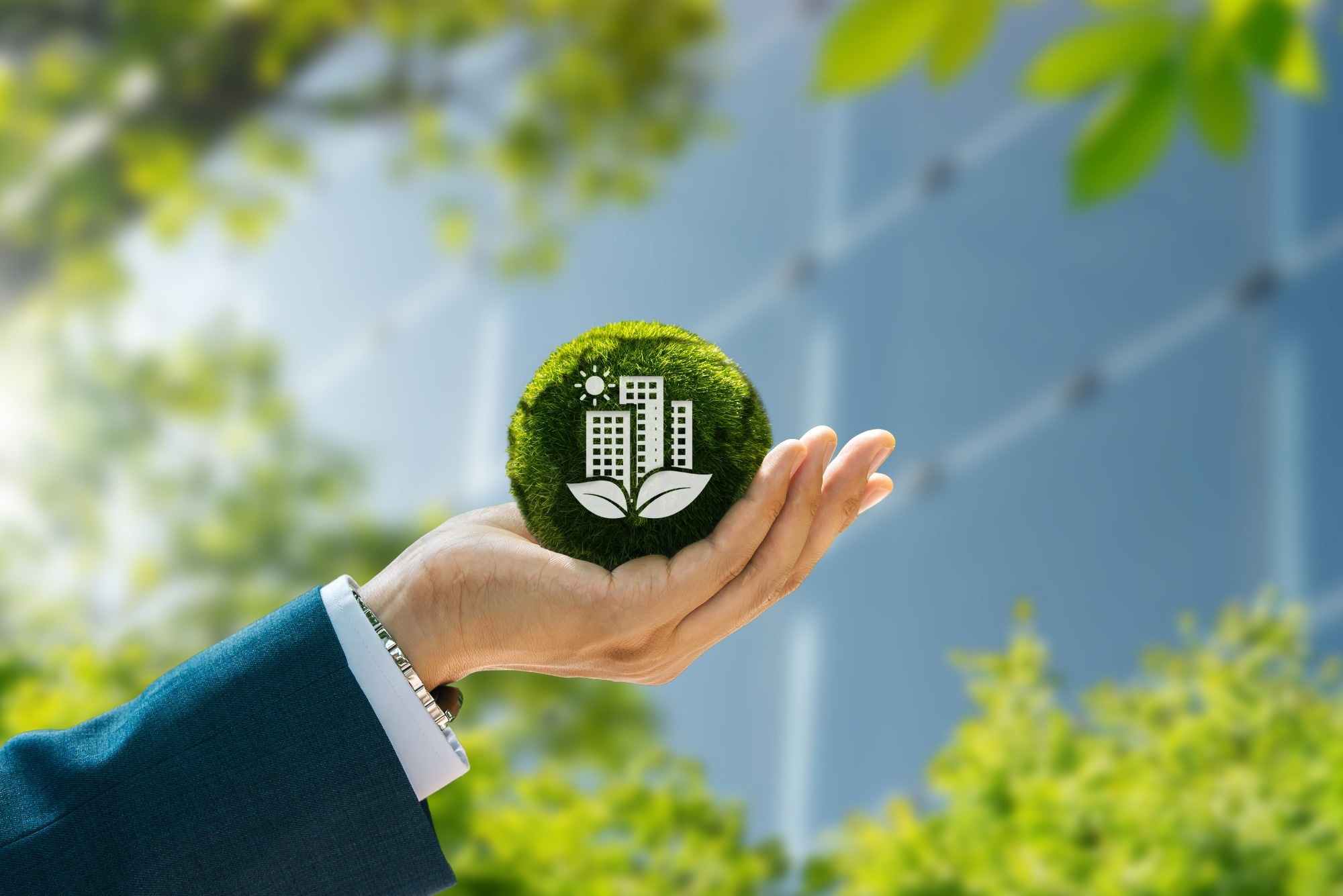 By JanakyReviewed by Susha Cheriyedath, M.Sc.Aug 22 2024
By JanakyReviewed by Susha Cheriyedath, M.Sc.Aug 22 2024Construction, while essential for societal well-being and improving quality of life, has a significant environmental impact. It is a major contributor to landfill waste and greenhouse gas emissions and consumes a substantial amount of global resources.

Image Credit: dee karen/Shutterstock.com
The globally endorsed solution to this issue is to integrate the concept of “Sustainability” into construction practices. Over the past few decades, sustainable construction (SC) has gained significant traction, particularly in developed countries.
Yet, this shift towards sustainability brings with it a range of challenges and complexities from managerial, strategic, and operational standpoints. With increasing environmental awareness, stricter regulations, and evolving consumer preferences, the construction industry faces an urgent need to adopt more sustainable practices.
The Environmental Impact of the Construction Industry
The construction industry is a major contributor to environmental degradation, with significant impacts on natural resources, biodiversity, and atmospheric conditions. Construction activities consume vast amounts of natural resources such as stones, gravel, sand, and virgin wood, contributing to substantial deforestation.
This extensive exploitation of non-renewable resources threatens the balance of natural reserves. Additionally, traditional construction practices generate large volumes of waste, including brick, concrete, and damaged wood. Due to inadequate recycling practices, much of this potentially reusable material ends up in landfills.
Beyond resource depletion, construction activities significantly affect biodiversity and the atmosphere. The industry is responsible for 39 % of process-related carbon dioxide emissions, exacerbating global warming. Air pollutants from construction sites, including dust particles like PM10, also pose serious risks to human health and wildlife.
Furthermore, current construction practices lead to habitat destruction and fragmentation, disrupting ecosystems and forcing wildlife to either adapt or face population declines. The growing awareness of these environmental impacts underscores the urgent need for more sustainable practices in the construction industry.
Regulations and Consumer Demand in Construction
There is a growing global effort to reduce the construction industry's environmental impact through stricter regulations and carbon footprint reduction targets. The construction sector’s significant role in air pollution, water contamination, and landfill waste has led to tougher standards, pushing the industry to embrace more sustainable practices.3
At the same time, changing consumer expectations are driving companies to innovate and adopt sustainability principles. In rapidly urbanizing areas like China, this shift towards sustainable construction (SC) opens up exciting new opportunities.
However, there are still obstacles to overcome, such as high costs, limited awareness, and insufficient legislative support. Building owners are crucial in promoting these practices, but their concerns about costs and regulations can slow progress. To advance sustainable construction globally, it is essential to address these challenges through government action and increased public awareness.
Technological Innovations in Sustainable Construction
The pressing need to tackle environmental challenges is driving technological innovations in construction. Technologies such as rooftop solar panels, photovoltaic cells, and active wind collectors are gaining traction for their ability to harness renewable energy.
Moreover, geothermal energy microgenerators, heat pumps, high-efficiency air conditioning systems, biofuel-based heating systems, and LED lighting are becoming increasingly popular in residential energy alternatives.4 Additionally, integrating nanoparticles into concrete or paints is enhancing the self-cleaning and anti-polluting properties of these materials.
Nanotechnology is also making strides with innovations like piezoelectric fabrics, which generate energy from movement and light. When used in building exteriors, these materials could transform structures into energy producers rather than consumers. Such advancements not only help reduce carbon emissions but also create jobs, boost productivity, and lead to significant energy savings.
Building designs are evolving to support sustainability goals, with a focus on taller, more efficient structures that increase urban density and reduce reliance on cars. While the adoption of new technologies has been gradual, the growing pressure to address environmental issues is likely to speed up innovation in the construction industry, steering it toward a more sustainable future.
Key technologies, such as Building Information Modeling (BIM), are crucial in this shift. BIM creates detailed digital representations of buildings, enabling precise planning, efficient resource management, and reduced waste throughout the construction process, which supports sustainable decision-making.
Certifications like LEED (Leadership in Energy and Environmental Design) in the US and BREEAM (Building Research Establishment Environmental Assessment Method) in the UK and Europe are becoming essential for setting standards in sustainable building practices. Additionally, the integration of artificial intelligence and sensors optimizes resource use, such as electricity and water, further advancing sustainability in construction.
Benefits of Sustainable Construction
SC not only enhances quality of life but also reduces negative impacts on the environment, human health, and biodiversity. By aligning with modern sustainable development goals, SC promotes environmental improvement, energy efficiency, and the well-being of future generations.
While the theoretical aspects of SC have been well-studied and documented, there is still a knowledge gap when it comes to applying this knowledge practically, especially in the socio-economic contexts of developing countries.5 Research from densely populated nations like China demonstrates a strong link between GDP growth and the adoption of SC, contributing to a stable macroeconomic environment.3
SC practices help mitigate environmental impacts by lowering carbon footprints and encouraging resource conservation through recycling and reuse.6 Moreover, sustainable buildings improve indoor air quality, utilize natural lighting, and enhance acoustic environments, thus enriching the quality of life for their occupants.
Investing in sustainable construction also benefits companies by strengthening community relations and fulfilling corporate social responsibility objectives. Beyond environmental advantages, sustainable buildings offer economic benefits such as reduced energy costs, lower long-term operational expenses, and higher property values, ensuring their marketability over time.5
Challenges and Future Outlook
SC applies sustainable development principles throughout the entire lifecycle of a building—from planning and construction to material extraction, production, usage, demolition, and waste management.1 This holistic approach aims to harmonize the natural and built environments, fostering communities with minimized environmental impact and promoting social progress.
A common misconception is that SC is prohibitively expensive due to higher upfront costs associated with sustainable materials and technologies. However, an article published in Energy Policy argues that, over time, the long-term savings on energy, water, and maintenance make SC cost-effective compared to initial expenses.7 Similarly, research in Sustainable Cities and Societies highlights that adhering to sustainability practices can reduce legal risks and future-proof buildings against evolving environmental regulations.8
Summary
Overall, it is clear that the construction industry frequently encounters challenges due to the variability and rapid evolution of sustainability regulations. This highlights the urgent need for professionals well-versed in sustainable construction practices. The transition toward sustainability in construction represents a fundamental shift that requires substantial investment in research and development. This effort will make SC more accessible worldwide and maximize its benefits for all stakeholders.
References and Further Reading
- Yılmaz, M., & Bakış, A. (2015). Sustainability in construction sector. Procedia-Social and Behavioral Sciences, 195, pp.2253-2262. DOI: 10.1016/j.sbspro.2015.06.312, https://www.sciencedirect.com/science/article/pii/S187704281503791X
- Lawrence, M. (2015). Reducing the environmental impact of construction by using renewable materials. Journal of renewable materials, 3(3), pp.163-174. DOI: 10.7569/JRM.2015.634105, https://www.ingentaconnect.com/contentone/tsp/jrm/2015/00000003/00000003/art00002
- Liu, Z. J., Pypłacz, P., Ermakova, M., & Konev, P. (2020). Sustainable construction as a competitive advantage. Sustainability, 12(15). DOI: 10.3390/su12155946, https://www.mdpi.com/2071-1050/12/15/5946
- Martin, L., & Perry, F. (2019). Sustainable construction technology adoption. In Sustainable construction technologies. Butterworth-Heinemann. DOI:10.1016/B978-0-12-811749-1.00009-2, https://www.sciencedirect.com/science/article/abs/pii/B9780128117491000092
- Fatourehchi, D., & Zarghami, E. (2020). Social sustainability assessment framework for managing sustainable construction in residential buildings. Journal of building engineering, 32. DOI: 10.1016/j.jobe.2020.101761, https://www.sciencedirect.com/science/article/abs/pii/S2352710220333945
- Torresin, S., et. Al., (2020). Acoustics for supportive and healthy buildings: Emerging themes on indoor soundscape research. Sustainability, 12(15). DOI: 10.3390/su12156054, https://www.mdpi.com/2071-1050/12/15/6054
- Belaïd, F., Ranjbar, Z., & Massié, C. (2021). Exploring the cost-effectiveness of energy efficiency implementation measures in the residential sector. Energy Policy, 150. DOI: 10.1016/j.enpol.2020.112122, https://www.sciencedirect.com/science/article/abs/pii/S0301421520308338
- Salvado, F., de Almeida, N. M., & e Azevedo, Á. V. (2020). Future-proofing and monitoring capital investments needs throughout the life cycle of building projects. Sustainable Cities and Society, 59. DOI: 10.1016/j.scs.2020.102159, https://www.sciencedirect.com/science/article/abs/pii/S2210670720301463
Disclaimer: The views expressed here are those of the author expressed in their private capacity and do not necessarily represent the views of AZoM.com Limited T/A AZoNetwork the owner and operator of this website. This disclaimer forms part of the Terms and conditions of use of this website.